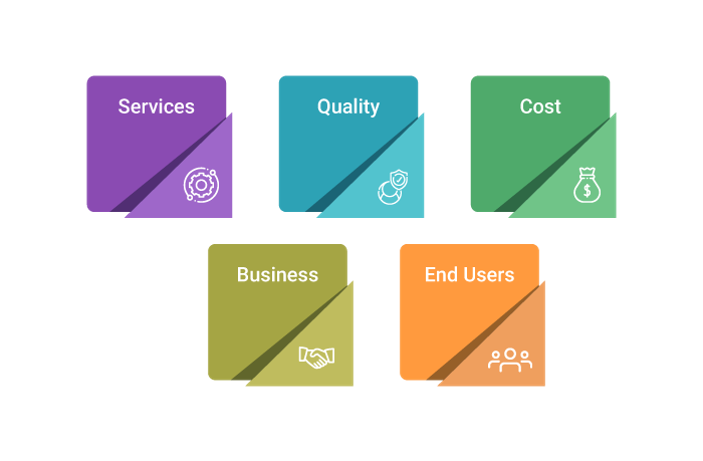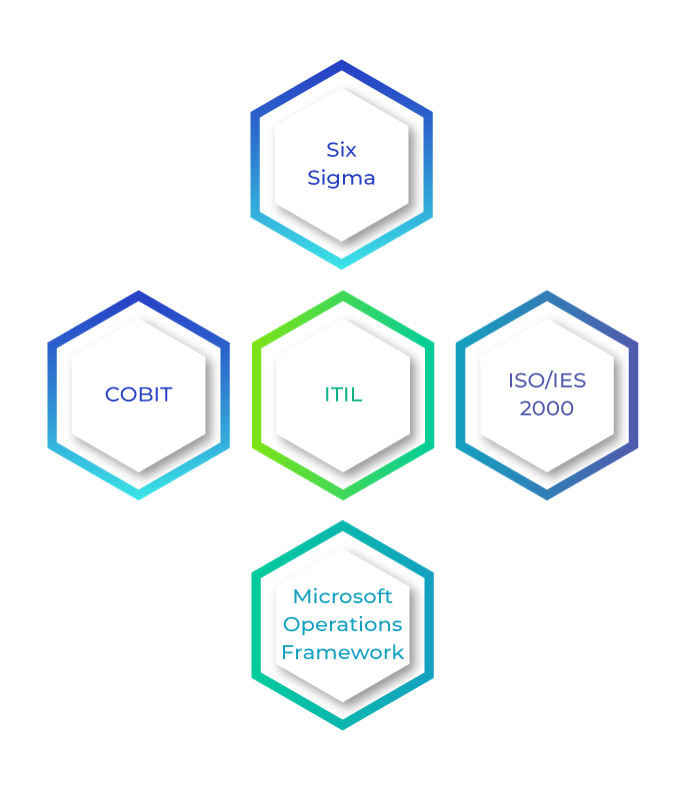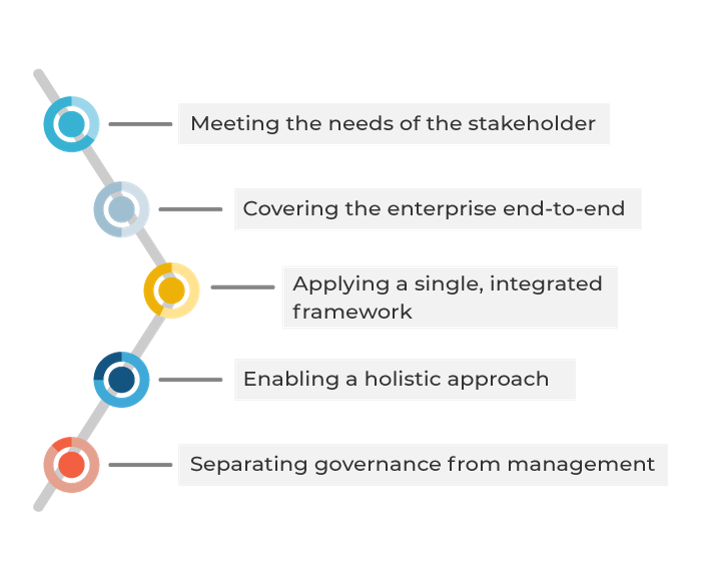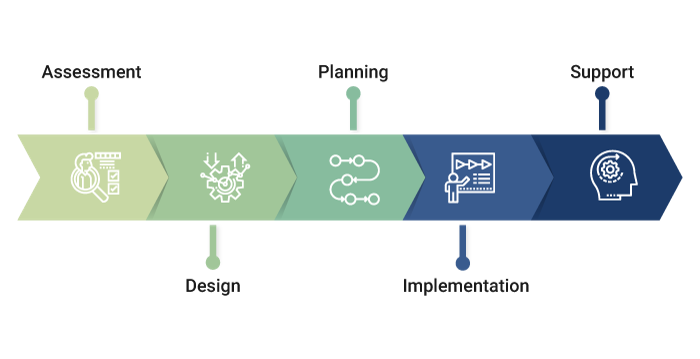
IT Service Management consists of all the activities which are executed by an organization for a customer. ITSM involves managing systems that provide value to customers. It is concerned with implementing IT services that meet the requirements of the customers. This is done by the IT service provider using a set of policies and procedures which are organized and structured into processes.
The main purpose of IT service management is to make sure that the appropriate processes, technology, and people are put in place to make sure that the organization can achieve its business goals.
Objectives of IT Service Management
The objectives of IT service management are:
- Analyze and determine the present IT infrastructure, services, and processes.
- Create management practices that are futuristic in nature.
- Formulate a roadmap to elevate the state of the business.
- Create steps for the roadmap.
Scope of IT Service Management
The following areas of concern can be addressed by ITSM:
- Services: ITSM can be implemented in IT applications, infrastructure, and hardware.
- Quality: The quality of services can be improved, and IT problems can be solved effectively and efficiently.
- Cost: Implementation of ITSM can help in keeping costs under control and stay within the budget.
- Business: ITSM allows a company to concentrate better on its core competencies in order to achieve its goals.
- End-users: The employees and customers who make use of IT services are also benefitted.
ITSM Frameworks
The common ITSM frameworks which are used to help an organization meet its business goals are:
ITIL
The Information Technology Infrastructure Library (ITIL) is a vital component of the ITSM framework, and the two terms are often used interchangeably. The governing body for ITIL is Axelos, which is a joint venture between the UK government and Capita. There are 5 stages of the ITIL service lifecycle:
- The first stage is Service strategy.
- Then we have, Service design.
- And then, Service transition.
- Followed with, Service operation
- And finally, Continual service improvement
COBIT
Control Objectives for Information and Related Technologies is a framework for IT governance that is used for developing, implementing, monitoring and improving the practices related to IT governance and management. The IT Governance Institute and the Information Systems Audit and Control Association (ISACA) are the publishers of COBIT. The latest version of COBIT focuses on the value of information governance and enterprise risk management.
The 5 main principles for governance and management of enterprise IT on which COBIT 5 is based are:
- Meeting the needs of the stakeholder
- Covering the enterprise end-to-end
- Applying a single, integrated framework
- Enabling a holistic approach
- Separating governance from management
SIX SIGMA
This is a framework for management that lays emphasis on improving product quality by measuring the defects and systematically eliminating them until there are nearly zero defects. It involves setting objectives that are extremely high, collecting the data, and analyzing the results to a fine degree in order to reduce the number of defects in products and services.
The Six Sigma methodology is executed using the DMAIC and the DMADV processes.
DMAIC
- Define: Identify the goals of the project
- Measure: Understand the present performance
- Analyze: Determine the root causes of defects
- Improve: Establish ways to eliminate defects
- Control: Manage the performance of the process in the future
DMADV
- Define: Identify the project goals
- Measure: Understand the present performance
- Analyze: Determine the root causes of defects
- Design: Create a process that satisfies the needs and expectations of the customers
- Verify: Make sure that the process satisfies the customer’s needs and performs adequately
ISO/IEC 20000
The ISO/IEC 20000 is a global standard for managing and delivering IT services that describe the minimum requirements of an ITSM system adequately. The conformance of the service management system (SMS) of an organization to ISO can be audited, and the organization can achieve the ISO/IEC 20000 for their service management system. The ISO 20000 was developed by the British Standards Institutions (BSI), which is an organization for international testing and certification.
Microsoft Operations Framework
The Microsoft Operations Framework is a set of 23 documents that are used by IT professionals to guide them in creating, implementing, and managing services in an efficient and cost-effective manner. This Microsoft Operations Framework (MOF) is an alternative to the Information Technology Infrastructure Library (ITIL). It provides guidelines for an entire IT service lifecycle from the inception of the concept to its retirement.
Implementation of IT Service Management Frameworks
The ITSM framework is implemented using a 5-step model. This includes the following:
- Assessment: The present state of the IT infrastructure in the organization is determined. Based on this, metrics for improvement are formulated.
- Design: Advanced designs are formulated for the organization based on the requirements.
- Planning: It is important to create appropriate plans which will help the business to evolve and grow.
- Implementation: The newly developed frameworks are implemented in order to ensure future growth.
- Support: After the frameworks have been implemented, it is essential to provide maintenance, management, and improvement services to all the IT plans across the organization.
Benefits of IT Service Management
Benefits for both the IT infrastructure and business are provided by the implementation of IT service management in an organization.
IT Service Management for IT
- It provides a better understanding of the needs of the business and the reason they are required.
- Implementation of ITSM results in increased productivity.
- It is a repeatable and scalable process
- It provides a set of well-defined roles and responsibilities.
- The end-users are satisfied as it provides them with realistic expectations.
- It can prevent IT issues before they can arise.
- It has the ability to identify the problems which are repeating and address them.
- The analytics helps to measure and improve the performance of the IT department.
IT Service Management for Business
- The IT department can quickly react to changes and innovations in the market.
- The availability of IT services and their performance is better which allows employees to be more productive.
- Issues relating to IT are not very common which translates into lower costs.
- The employees are aware of the availability of the services and the procedure to use them.
Conclusion
When effective IT service management is put to use in an organization, the use of appropriate frameworks, processes, and resources are also enhanced in terms of efficiency. This in turn helps the organization to achieve its goals easily. Learn more about service management with ITIL 4 Foundation certification training, and fill your professional expertise with the best service management skills and best practices.
Know more about Service Management best practices through Invensis Learning’s IT Service Management certification training on ITIL Foundation Certification, SIAM Foundation, SIAM professional, VeriSM, etc.
















